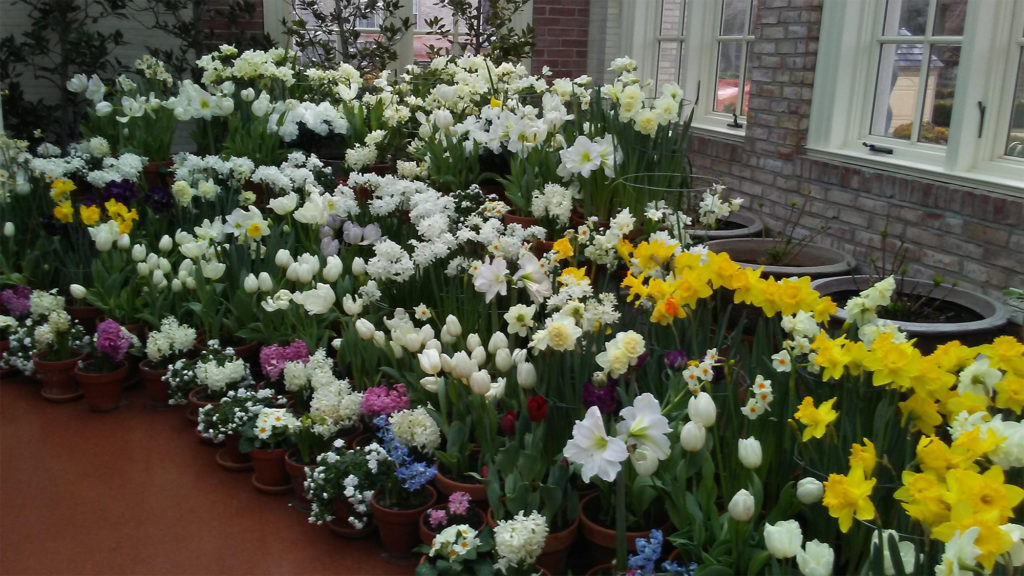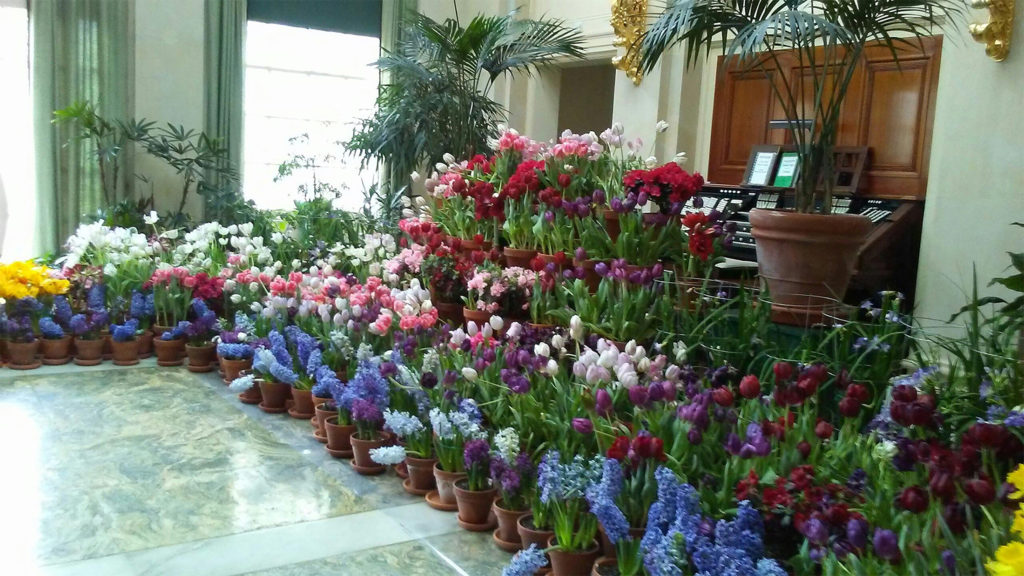Village Gardener – Tulips
by Georgeanne Vyverberg –

On a particularly raw and windy day at the end of February, I decided I needed at least the illusion of Spring. The George Eastman house in Rochester was in the final day of its annual Dutch Tulip Display Days. Thousands of tulips and daffodils transform Mr. Eastman’s estate home into a veritable Spring garden. The sight of so much color and the odor of plants and soil were a balm to my starving gardener’s soul. Since it was a Sunday and the last day of this yearly event, it was crowded and we were forced to go slowly, but this made It possible to read several posters scattered about explaining Mr. Eastman and his love of gardens. He had no less than nine on the estate. On a trip to Europe which included Holland he was amazed at the floral displays of tulips and decided he must have them in his gardens. He ordered thousands and added more every year. The fortunate thing about the Eastman House is there were garden designs and lists of plants that had graced the gardens still in existence. One such list of 100 tulip cultivars was posted. Of these only a small number, less than ten percent are still available. Mostly it was due to the changing popularity of colors and shape and much was due to the difficulty of growing tulips which had the strange habit of changing colors. It was not until the 1920’s when it was discovered that a virus from peaches could cause a carefully grown white tulip to morph into something with bright feathers and streaks on the white background. However, these changes made some of these cultivars extremely valuable. Gardeners haven’t changed much. We always want the newest thing.

Tulips can be grown by seed or offsets from the bulb and there are challenges for both forms. Seeds can be sown of an individual and usually produce a variety of colors. One can be picked from these seedlings but it may take up to seven years before the bulb matures enough to flower. Offsets are smaller bulbs formed from the parent bulb and these will breed true to the parent. The virus that caused color variation has been mostly eradicated. It may take a year or two more but you will have a flower. The original mother bulb gets weaker every year producing offsets and dies. Another form is by laboratory tissue culture. Most of what are available today are hybrids.
If you ask most people where tulips come from, the answer will probably be Holland. It’s true that today Holland is the largest grower of tulip
s in the world, but like so many of our garden plants they originated in Central Asia where they grew wild on the craggy, rocky slopes of mountains. Some populations were in North Africa and the Southern Iberian Peninsula. These plants were valued by the rulers of these kingdoms. They began to be noticed in the 15th and 16th centuries by European travelers, who brought them back to Europe, where they were cultivated mostly in the gardens of the wealthy. They were a sort of status symbol. Amsterdam, which was becoming an important seaport seemed to be at the height of a frenzy, which became known as Tulipomania. From 1634-1637 the bulbs were literally worth their weight in gold in a sort of “futures” game, where bulbs in the ground were bought and sold unseen based on the weight of the bulbs when planted. Fortunes were won and lost in those three years. Anna Pavord, writes in her two inch thick book THE TULIP “…tradesmen mortgaged their homes, weavers their looms.” Think of that when you purchase a bag of tulips for planting this Fall. Myself I won’t be able to look at tulips in quite the same way again.
Georgeanne has been fascinated by plants ever since a neighbor gave her some flower seeds when she was very young. The magic of watching them sprout into beautiful flowers has become a lifetime of wonderment. She lives in Honeoye Falls with her canine and feline friends, small flock of chickens and more recently a rabbit, or two.